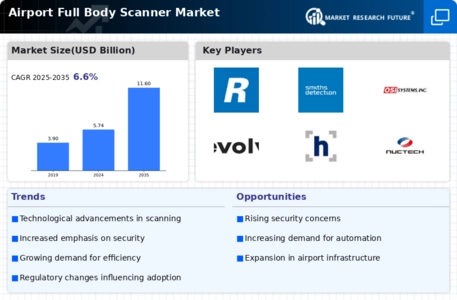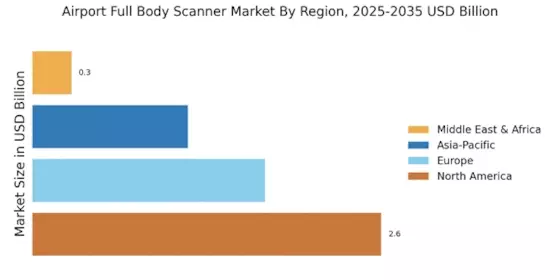Regulatory Compliance
Regulatory frameworks significantly influence the Airport Full Body Scanner Market. Governments and aviation authorities are increasingly mandating the use of advanced screening technologies to comply with international security standards. This regulatory push is likely to drive the adoption of full body scanners across various airports. Compliance with regulations not only enhances security but also fosters public trust in air travel. As a result, airports are investing in full body scanners to meet these requirements, which is expected to contribute to market growth. The ongoing evolution of regulations suggests that the industry will continue to adapt, ensuring that security measures remain effective and aligned with global standards.
Rising Air Travel Demand
The continuous increase in air travel demand is a significant driver for the Airport Full Body Scanner Market. As more passengers opt for air travel, airports are faced with the challenge of efficiently managing security without compromising safety. The growing number of travelers necessitates the implementation of advanced screening technologies, including full body scanners, to expedite the security process. Market data indicates that the air travel sector is projected to expand, leading to a corresponding rise in the demand for effective security solutions. This trend suggests that the industry will likely experience sustained growth as airports strive to accommodate the influx of passengers while maintaining high security standards.
Technological Innovations
Technological advancements play a crucial role in shaping the Airport Full Body Scanner Market. Innovations such as millimeter wave technology and advanced imaging algorithms have improved the efficiency and accuracy of body scanners. These developments not only enhance detection capabilities but also reduce false alarm rates, thereby streamlining the screening process. The market is witnessing a shift towards more sophisticated systems that integrate artificial intelligence and machine learning, which could potentially revolutionize the way security checks are conducted. As airports seek to modernize their security infrastructure, the demand for cutting-edge full body scanners is expected to rise, indicating a robust growth trajectory for the industry.
Increased Security Concerns
The heightened focus on security in the Airport Full Body Scanner Market is driven by the need to prevent potential threats. As incidents of terrorism and criminal activities at airports have increased, authorities are compelled to adopt advanced screening technologies. The implementation of full body scanners is seen as a proactive measure to enhance passenger safety. According to recent data, the market for airport security equipment, including full body scanners, is projected to grow significantly, reflecting the urgency of addressing security vulnerabilities. This trend indicates that investments in advanced scanning technologies are likely to continue, as stakeholders prioritize the safety of travelers and airport personnel alike.
Enhanced Passenger Experience
Improving the passenger experience is becoming increasingly important in the Airport Full Body Scanner Market. Airports are recognizing that efficient security processes can significantly enhance traveler satisfaction. Full body scanners, which can expedite the screening process, are being adopted to minimize wait times and improve overall efficiency. By integrating user-friendly technologies, airports aim to create a more pleasant travel experience. Market trends indicate that passengers are more likely to favor airports that prioritize convenience and efficiency in security checks. This focus on enhancing the passenger experience is expected to drive the demand for full body scanners, as airports seek to balance security needs with customer satisfaction.


















Leave a Comment